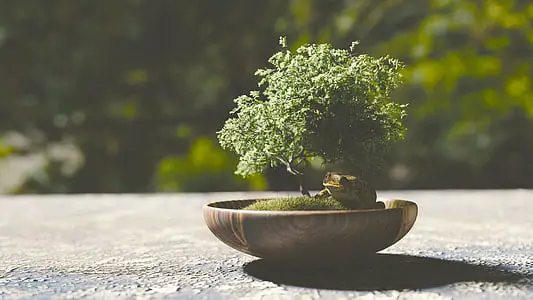Can Bonsai Trees Produce Fruit?
while looking at a bonsai tree have you ever wondered is it really possible for a bonsai tree to bear fruits? Can bonsai trees produce fruits? Well, you are not alone looking at the size of a bonsai tree and its growing pot the question always pops up.
To give you the answer yes, a bonsai tree can produce fruits. If in nature a tree is a fruiting tree it will bear fruits even if it is growing as a bonsai plant.
As a matter of fact, A bonsai fruit tree is actually a standard fruit tree that has been trained to grow into a miniature size.
You can make bonsai from endless varieties of trees. So if you want to make a bonsai with fruit choose a tree that naturally produces fruits. For the best result select plants that produce small-sized fruits.
The reason for this is that though we can reduce the size of the leaves, stem, and branches of a plant using pruning and other methods. It is simply not possible to reduce the size of the fruits or flowers.
So it will look very odd if your bonsai has large-sized fruits that don’t look in symmetry with the plant.
What Are The Best Trees For Making A Bonsai
There are a handful of trees that will produce fruits when they are converted to a bonsai. These are ideal trees for making a bonsai tree. Below are seven popular bonsai trees with fruits.
Pomegranate:

Pomegranate bonsai is a very popular fruit bonsai. These plants can tolerate drought. So it is crucial that the bonsai roots of a Pomegranate tree must not get too wet. It can cause fungal infection. The light requirement of a Pomegranate bonsai is full sunlight for 6 hours.
Pomegranate has trumpet-shaped red flowers and large round red fruit. Though they are mainly grown for fruits you can also use them for ornamental purposes.
Use a liquid bonsai fertilizer every two weeks from spring to autumn. You can also help the Pomegranate tree by adding pulverized organic fertilizer in mid-spring.
Choose a fertilizer with low nitrogen and high phosphorus and potassium content. This will promote flowers and fruit on mature trees.
Gradually, reduce the roots of your pomegranate tree. Never remove more than one-third of the root ball.
Pomegranate trees are prone to mold problems. Make sure you have good airflow. Use a mild fungicide if the problem persists.
Ficus:

Keep your Ficus bonsai outside in summer. They cannot tolerate frost. Too much shade can also harm your bonsai.
They also love high levels of humidity. Add a little bit of mist to increase the humidity level.
Add water when you feel the soil is dry. A little bit of over or under watering does not harm your bonsai.
For fertilizing your ficus you can apply liquid fertilizer can be used as well as organic fertilizer pellets.
The fruit of the ficus bonsai can be yellow, green, red or purple-blue. they are relatively smaller in size (a few millimeters)
Cherry Laurel:
Cherry laurel is a great option for bonsai trees starters.
They have white flowers. That is, in turn, converted into black edible fruits. Keep them outside. Full sun is the ideal for cherry laurels but you can also use partial shade.
Apple:

People also prefer to grow apple bonsai trees. They have dense leaves, flowers, and fruits. You can grow an apple bonsai both indoors as well as outdoors.
Water regularly. make sure the soil should be moist and not waterlogged.
feed your apple tree with liquid fertilizer twice a month. stop fertilizing your bonsai when it is fruiting.
Japanese Winterberry:

Japanese winterberries are a very popular bonsai fruit tree. The female trees produce spectacular red berries.
Place your winterberry tree outside where they can get full sunlight. Water your bonsai before the soil dries out completely.
Lemon:

You can easily convert a lemon tree into a bonsai. It is quite a popular choice among citrus plants.
They grow best under full sunlight. Lemon trees will have vibrant dark green leaves and beautiful fragrant spring flowers.
Lemon bonsais trees and dwarf lemon trees are not the same things. A lemon bonsai are normal-sized trees but grown in their miniature versions.
If you can prune properly, these lemon bonsai will bear edible fruits. the sizes will be in proportion to the tree and will have similar qualities like the regular size lemon fruits.
Crabapple:

Crabapple is a native plant to Japan. They bear beautiful white, fragrant flowers in early spring and it covers the entire tree.
The crabapple foliage is really small and lobed. They bear little green fruits which will later turn into other colors when they ripen.
Throughout the spring, summer and fall place your crabapple bonsai outside, so it can receive sufficient sunlight. Morning sun and afternoon shade are best for your bonsai.
A crabapple tree is generally pest and disease resistant and is quite easy to grow.
How To Grow A Bonsai Fruit Tree
Though a bonsai tree is a miniature version of the normal tree, the fruit size is not reduced. As a matter of fact, you cannot reduce the size of a plant without altering its genetics.
When you grow a bonsai you don’t change their genetics but rather train the plant to grow in a very different condition than in its natural habitat.
Can We Eat Fruits Grown in Bonsai Trees?
If you are thinking that is alright but are bonsai fruits edible? Can we eat fruits grown in a bonsai tree, then let me assure you, the fruits of a bonsai tree is the same as the fruit of a normal tree.
You can certainly eat those fruits if you like.
